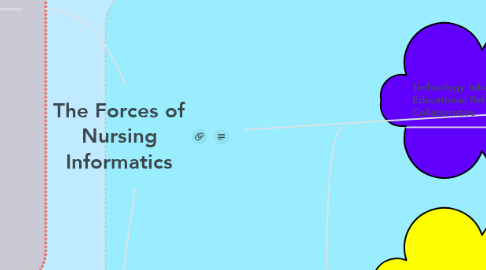
1. Nursing Forces
1.1. Technology Informatics Guiding Educational Reform: TIGER Collaborative
1.1.1. Making nursing informatics a standard competency
1.2. American Nurse's Association
1.2.1. Incorporation of nursing informatics into education curriculum
1.2.2. The Scope and Standards of Practice for Nursing Informatics
1.3. National Center for Nursing Research
1.3.1. Set goals for nursing informatics research to build clinical databases and methods to evaluate nursing information systems
1.4. National Advisory Council on Nurse Education and Practice
1.4.1. "Nursing informatics supports telehealth, telehealth in nursing practice, secondary use of data, privacy, commercial and experimental telehealth applications, and ethical, legal, and social concerns"
1.5. American Nursing Informatics Association
1.5.1. To advance nursing informatics through education, research, and practice in all roles and settings.
1.5.2. To be the organization of choice to advance nursing informatics.
2. Consumer Forces
2.1. Electric medical record compatibility
2.2. Patient safety and Patient-care-center
2.3. Healthcare system costs: reduces medical errors
2.4. Able to engage in the decision-making process and in health care processes and decisions
2.5. patient-focused informatics, health literacy, and consumer education, with a focus on information structures and processes that empower consumers to manage their own health
3. National Forces
3.1. The Institute of Medicine
3.1.1. An adviser to the US government to improve healthcare
3.1.2. Advocates informatics as a required core competency
3.1.3. Advocates information infrastructure, computerized clinical data, and evidence-based practice integration
3.2. President's Information Technology Advisory Committee (PITAC) - Archive
3.2.1. A Federal Advisory Committee
3.2.2. Involved in networking and information technology research and development with expert, independent advice
3.2.3. Maintaining America's preeminence in advanced information technologies
3.2.4. Maintaining the national information technology infrastructure as high performance computing, large-scale networking, cyber security, and high assurance software and systems design
3.3. Office of the National Coordinator for Health Information Technology
3.3.1. A resource to the entire health system
3.3.2. Support the adoption of health information technology and the promotion of nationwide health information exchange to improve health care
3.4. Health Information Technology
3.4.1. Computerized Clinical Data
3.4.2. Electronic health records (EHRs)
3.4.3. Personal health records (PHRs)
3.4.4. Electronic prescribing (E-prescribing)
3.4.5. Privacy and security
3.5. American Medical Information Association
3.5.1. A community committed to the vision of a world where informatics transforms people’s care.
